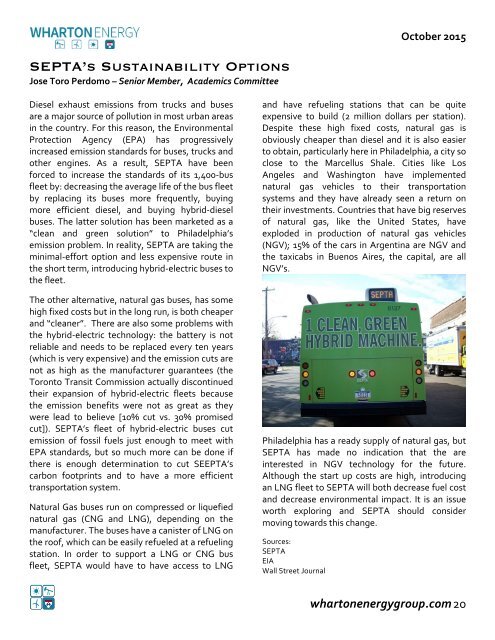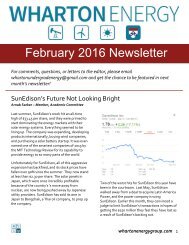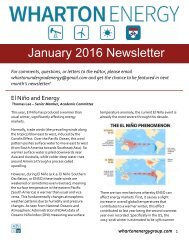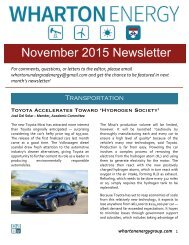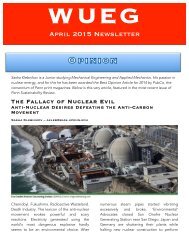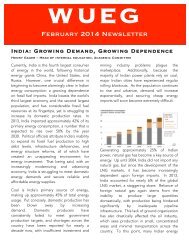Create successful ePaper yourself
Turn your PDF publications into a flip-book with our unique Google optimized e-Paper software.
<strong>October</strong> <strong>2015</strong><br />
SEPTA’s Sustainability Options<br />
Jose Toro Perdomo – Senior Member, Academics Committee<br />
Diesel exhaust emissions from trucks and buses<br />
are a major source of pollution in most urban areas<br />
in the country. For this reason, the Environmental<br />
Protection Agency (EPA) has progressively<br />
increased emission standards for buses, trucks and<br />
other engines. As a result, SEPTA have been<br />
forced to increase the standards of its 1,400-bus<br />
fleet by: decreasing the average life of the bus fleet<br />
by replacing its buses more frequently, buying<br />
more efficient diesel, and buying hybrid-diesel<br />
buses. The latter solution has been marketed as a<br />
“clean and green solution” to Philadelphia’s<br />
emission problem. In reality, SEPTA are taking the<br />
minimal-effort option and less expensive route in<br />
the short term, introducing hybrid-electric buses to<br />
the fleet.<br />
The other alternative, natural gas buses, has some<br />
high fixed costs but in the long run, is both cheaper<br />
and “cleaner”. There are also some problems with<br />
the hybrid-electric technology: the battery is not<br />
reliable and needs to be replaced every ten years<br />
(which is very expensive) and the emission cuts are<br />
not as high as the manufacturer guarantees (the<br />
Toronto Transit Commission actually discontinued<br />
their expansion of hybrid-electric fleets because<br />
the emission benefits were not as great as they<br />
were lead to believe [10% cut vs. 30% promised<br />
cut]). SEPTA’s fleet of hybrid-electric buses cut<br />
emission of fossil fuels just enough to meet with<br />
EPA standards, but so much more can be done if<br />
there is enough determination to cut SEEPTA’s<br />
carbon footprints and to have a more efficient<br />
transportation system.<br />
Natural Gas buses run on compressed or liquefied<br />
natural gas (CNG and LNG), depending on the<br />
manufacturer. The buses have a canister of LNG on<br />
the roof, which can be easily refueled at a refueling<br />
station. In order to support a LNG or CNG bus<br />
fleet, SEPTA would have to have access to LNG<br />
and have refueling stations that can be quite<br />
expensive to build (2 million dollars per station).<br />
Despite these high fixed costs, natural gas is<br />
obviously cheaper than diesel and it is also easier<br />
to obtain, particularly here in Philadelphia, a city so<br />
close to the Marcellus Shale. Cities like Los<br />
Angeles and Washington have implemented<br />
natural gas vehicles to their transportation<br />
systems and they have already seen a return on<br />
their investments. Countries that have big reserves<br />
of natural gas, like the United States, have<br />
exploded in production of natural gas vehicles<br />
(NGV); 15% of the cars in Argentina are NGV and<br />
the taxicabs in Buenos Aires, the capital, are all<br />
NGV’s.<br />
Philadelphia has a ready supply of natural gas, but<br />
SEPTA has made no indication that the are<br />
interested in NGV technology for the future.<br />
Although the start up costs are high, introducing<br />
an LNG fleet to SEPTA will both decrease fuel cost<br />
and decrease environmental impact. It is an issue<br />
worth exploring and SEPTA should consider<br />
moving towards this change.<br />
Sources:<br />
SEPTA<br />
EIA<br />
Wall Street Journal<br />
whartonenergygroup.com 20


